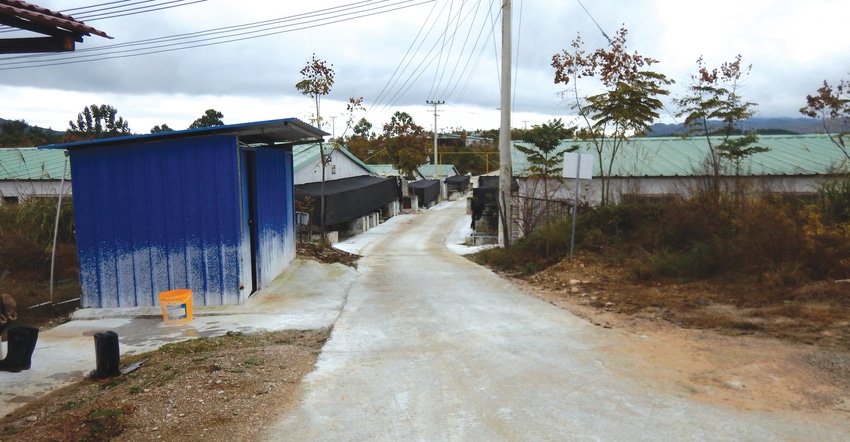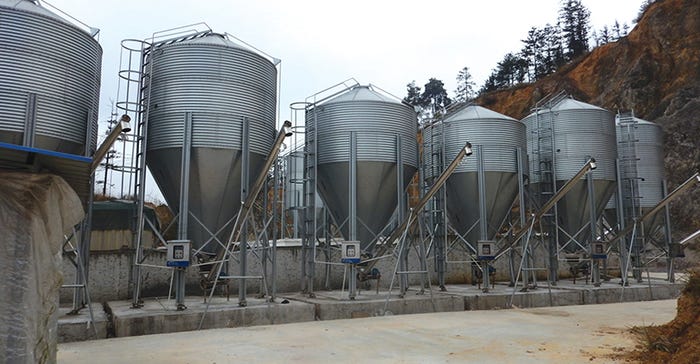Veterinarian shares observations of China's African swine fever eradication efforts.

Before the COVID-19 pandemic, Tom Gillespie spent his fair share of time in China getting a firsthand glimpse into the African swine fever eradication efforts there.
"ASF is the enemy, and I can't stress that enough on how China, at least the farms that I'm working on routinely, has responded to this challenge," Gillespie says. "It's really a war that they're in, and they have responded accordingly."
A swine veterinarian for more than 40 years and the owner of Performance Health PC, Gillespie, whose home is in Indiana, has spent a fair share of time in the south-central region of China.
While he's still seeing some cultural norms in Chinese pig production such as backyard pigs, Gillespie says he's also seeing a seismic shift from less midsize to more intensive production, especially since ASF.
Knowing culture is essential
To understand the whys and hows of ASF in China, one has to understand the cultural aspects that have helped carry this virus around China and countries in Southeast Asia.
"The government wants big units, so they're wanting to change the industry as we speak — and it's changing, it's changing very rapidly," Gillespie says. "Last August I gave a talk to a unit that has 46 sow units today, and their goal is to build 50 new units this year."
Now, with coronavirus on the human side, in addition to ASF in swine, Gillespie says China is learning very quickly about the importance of biosecurity, but it hasn't been easy battling ASF virus.
Battling ASF virus
ASFV is a large, enveloped DNA virus with some genotypes being a DNA "arbovirus" (transmitted by ticks; the name comes from "arthropod-borne"). There have been 22 genotypes of the ASFV identified globally and they vary in virulence.
Some high-virulence strains have an impact of nearly 100% mortality in herds, while others show seroconversion with low mortality rates. The virus can infect monocytes and macrophages.
"I've seen, over several weeks, 96% mortality in a finisher barn," Gillespie says. "It likes to get in white blood cells and red blood cells. One drop of blood can have over 300 copies of this virus, so it proliferates quite a bit."
The environmental persistence is characteristic of ASFV. The virus is resistant and persistent in the environment. Some strains not only survive but also remain infectious across a range of pHs from 4 to 13.
Different studies report virulent activity for ASFV strains stored for more than five years at 41 degrees F, for 18 months at 68 degrees, and between 10 and 30 days at 98.6 degrees. The virus can survive in soils or animal feces for five to six months and up to 30 months in chilled meat.
"I can tell you by March of last year, nobody had had a successful repopulation. First, the producers were trying to quickly react to the initial reporting in August 2018, although it quickly moved around China to depopulate their farms. Depopulation alone created a trying time to get their sites cleaned up," Gillespie says.
"The next step was a struggle in how to 're-pop' and stay clean. Their program at that time was to put some sentinel pigs in and see if there was disease or an antibody response. I participated in a workshop, and one guy had 17,000 sows that he had to depopulate. One of the take-homes was, three months was not long enough for the site to be depopulated and cleaned. They had chosen six months, and by August last year I heard positive results on repopulation."
Update on repopulation
The industry continues to struggle with a site staying clean after repopulation. Some thought is reinfection through semen, or feed — or the site was not cleaned and disinfected well enough, even though it was empty for months.
"We were talking about biosecurity, and I mentioned the rodent program, the bait stations. I said, 'Who's in control of that?' The farm's response was 'Well, we hired a firm. They come here four times a year.' And I said, 'Well, look at the feed that's dribbling out of this auger,'" Gillespie says.
"The next day they had temporary plastic bags on the boot of every bin on that farm, a 10,000-sow farm — that's how quick they will respond to make improvements, because they want to do better."
Gillespie works with farms in Guizhou province as well as the city of Chengdu (about 350 miles northwest of Guizhou), and says some have gone above and beyond on their biosecurity programs since ASF. For instance, one production system he routinely consults for has the financial means to take much more exhaustive measures.
The first thing the production system did to its site with 10,000 sows was to put up a perimeter fence — even though there are eight to 10 backyard farms just outside the fence, Gillespie says, which is a continuing cause of concern.
They have changed from a bagged feed system to bulk deliveries with trucks filling newly constructed bulk bins that are just inside the front gate.
There is isolation on-site for gilts and boars. They now have in place an intense diagnostic monitoring system for both healthy and sick animals. A dormitory is on-site for the 115 employees, including four who are chefs who do all on-site cooking.

Site entrance requirements
To get into the site, Gillespie must spend one night of downtime prior to arrival at the farm. He is then required to take two showers — 10 minutes long each, with farm clothes changed in between — and then must spend one more night in isolation and one or two nights in the dormitory before being allowed into production.
"They do lots of PCRs [polymerase chain reactions]. ASFV was officially announced in August in the country, and by mid-November, they had already determined that the employees that do leave to go home for a week or two, when they come back, they were positive — either their hair, hands or the shoes were positive for ASFV," he says.
"Think about that; in just two to three months, it has seeded itself down at people's homes, restaurants, towns — everywhere for the person to be positive coming back to work."
The company whose operations Gillespie visited is now requiring employees to take a daily shower to get into their local headquarters and feed mill, which produces 140 million metric tons annually.
It is building a new road to separate entry and exit for feed deliveries, and are putting up car washes for employees to use before driving into the farm.
At the front gates, trucks are now getting washed down with disinfectant. They even have a biosecurity lead person to monitor the biosecurity with electronic surveillance in their main "command" room, who monitors employee actions through an extensive camera network.
Gillespie says some measures are making a notable difference. For example, the feed mills are heating feed to try to reduce the presence of ASFV. The serological results have shown that the biosecurity program is making a difference on other pathogens.
At their Sept. 11 and Sept. 22 samplings, besides porcine reproductive and respiratory syndrome diagnostics, other pathogens including classical swine fever, porcine circovirus type 2, toxoplasma, Mycoplasma suis and swine chlamydiosis were tested by PCR. The results indicated the animals on the site were negative for all of the tests.
If a site breaks with ASFV, sometimes a "test and removal" approach is performed. This means that any sick animal is tested — usually tissue tests using PCR — and if positive, circle testing and removal are performed. It has not always been successful, though; the thought is based on the slower transmission of the virus within the population.
Gillespie says these changes have been positive to see, but the virus is affecting pork supply on a global basis and people are making changes around the world due to ASF, despite cultural norms.
"We can't really ignore the human aspects anymore when it comes to biosecurity," Gillespie says.
About the Author(s)
You May Also Like





